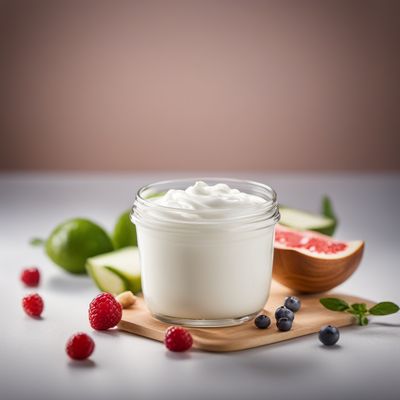
Ingredient
Soya yoghurt
The Creamy Delight of Soya Yoghurt
Soya yoghurt is made by fermenting soya milk with live cultures, resulting in a smooth and creamy texture with a slightly tangy flavor. It is a nutritious option that provides essential amino acids, vitamins, and minerals while being low in saturated fat and cholesterol.
Origins and history
Soya yoghurt originated in Asia, where soya beans have been cultivated for thousands of years. It has been a staple in Asian cuisines, particularly in countries like China and Japan. Over time, it gained popularity worldwide as a dairy-free alternative for those seeking a plant-based lifestyle or dealing with lactose intolerance.
Nutritional information
Soya yoghurt is a good source of plant-based protein, calcium, and vitamins like B12 and D. It is also lower in calories and saturated fat compared to dairy yoghurt, making it a healthier choice for individuals looking to reduce their intake of animal products or manage their weight.
Allergens
Soya yoghurt may contain soy, which is a common allergen. Individuals with soy allergies should exercise caution and read the labels carefully before consuming soya yoghurt or any soy-based products.
How to select
When selecting soya yoghurt, look for brands that use organic, non-GMO soya beans and minimal additives or sweeteners. Opt for plain or unsweetened varieties to have more control over the flavor and sweetness in your recipes. Additionally, check the expiration date to ensure freshness.
Storage recommendations
To maintain the freshness and quality of soya yoghurt, store it in the refrigerator at temperatures below 40°F (4°C). Keep it tightly sealed to prevent the absorption of odors from other foods. Consume it within the recommended shelf life mentioned on the packaging.
How to produce
Soya yoghurt can be produced at home by fermenting soya milk with a starter culture or by using store-bought soya yoghurt as a starter. The process involves heating the soya milk, adding the starter culture, and allowing it to ferment at a specific temperature for a certain duration. Detailed recipes and instructions can be found in cookbooks or online resources.
Preparation tips
Soya yoghurt can be enjoyed as a standalone snack, added to smoothies, used as a topping for granola or fruit, or incorporated into recipes that call for traditional dairy yoghurt. It can be used in baking, dressings, dips, sauces, or as a base for creamy desserts like parfaits or puddings.
Substitutions
Greek yoghurt, coconut yoghurt, or almond yoghurt can be used as substitutes for soya yoghurt. However, keep in mind that the flavor and texture may vary slightly, so adjust the quantities accordingly.
Culinary uses
Soya yoghurt is a versatile ingredient that can be used in both sweet and savory dishes. It is commonly used in vegan or dairy-free recipes, such as smoothies, overnight oats, vegan cheesecakes, creamy pasta sauces, and dairy-free yoghurt bowls.
Availability
Soya yoghurt is widely available in grocery stores, health food stores, and supermarkets. It can also be purchased online from various retailers. Its availability may vary depending on the region and demand for plant-based products.
More ingredients from this category

Imitation cream
"Creamy Delight: Unveiling the World of Imitation Cream"

Imitation yoghurt, non soy
Creamy Delight: Exploring Non-Soy Imitation Yoghurt

Tofu
Silken Delight

Imitation cheese
"Melting the Myths: Unveiling the World of Plant-Based Cheese Alternatives"

Non dairy coffee creamer
The Creamy Coffee Companion

